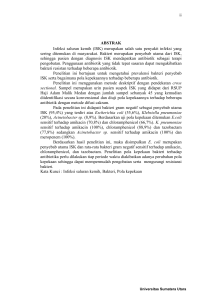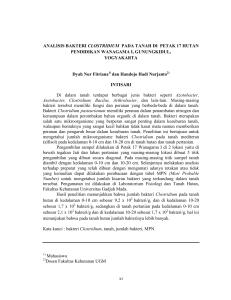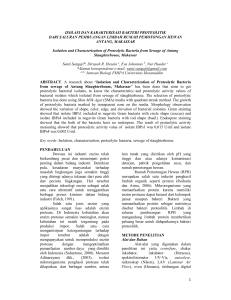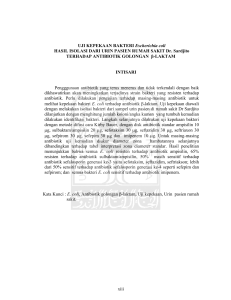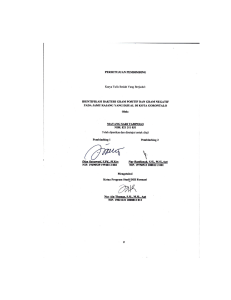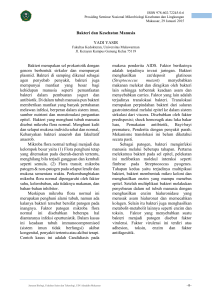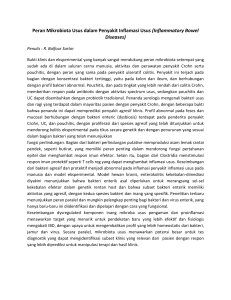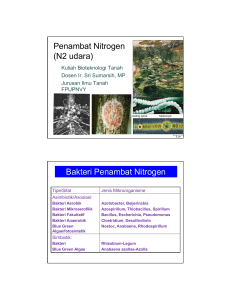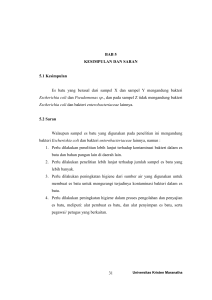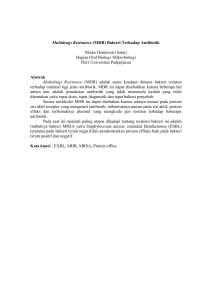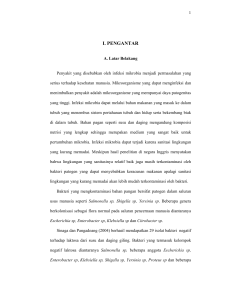Pola dan Sensitivitas Antibiotik Bakteri Yang Berpotensi Sebagai
advertisement
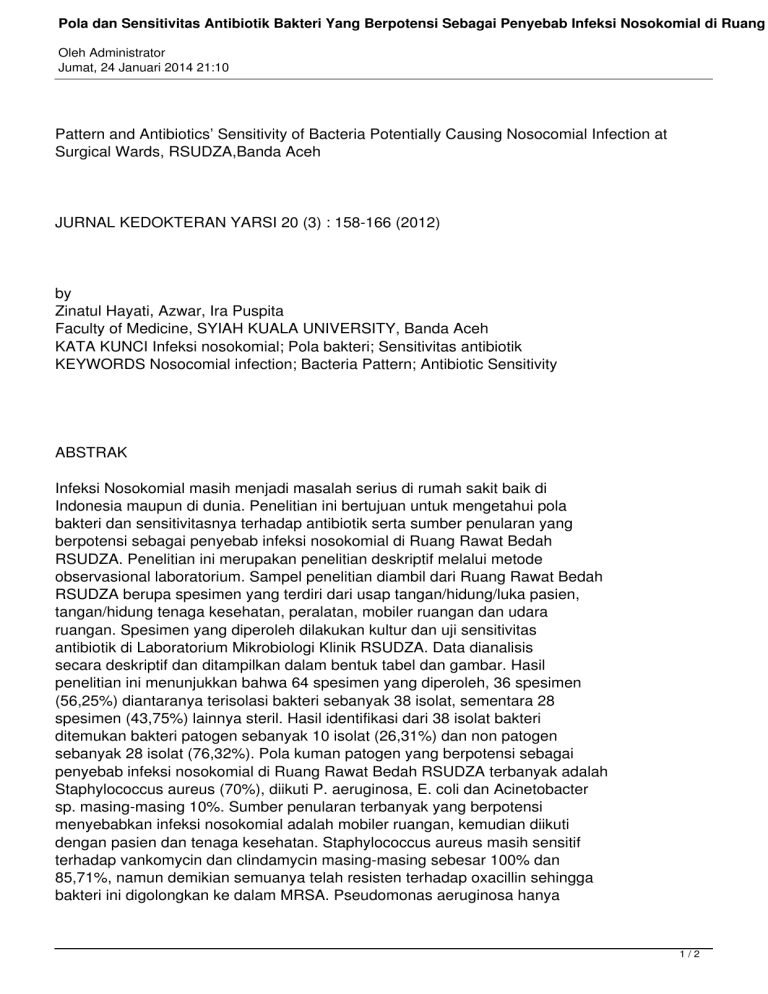
Pola dan Sensitivitas Antibiotik Bakteri Yang Berpotensi Sebagai Penyebab Infeksi Nosokomial di Ruang Oleh Administrator Jumat, 24 Januari 2014 21:10 Pattern and Antibiotics’ Sensitivity of Bacteria Potentially Causing Nosocomial Infection at Surgical Wards, RSUDZA,Banda Aceh JURNAL KEDOKTERAN YARSI 20 (3) : 158-166 (2012) by Zinatul Hayati, Azwar, Ira Puspita Faculty of Medicine, SYIAH KUALA UNIVERSITY, Banda Aceh KATA KUNCI Infeksi nosokomial; Pola bakteri; Sensitivitas antibiotik KEYWORDS Nosocomial infection; Bacteria Pattern; Antibiotic Sensitivity ABSTRAK Infeksi Nosokomial masih menjadi masalah serius di rumah sakit baik di Indonesia maupun di dunia. Penelitian ini bertujuan untuk mengetahui pola bakteri dan sensitivitasnya terhadap antibiotik serta sumber penularan yang berpotensi sebagai penyebab infeksi nosokomial di Ruang Rawat Bedah RSUDZA. Penelitian ini merupakan penelitian deskriptif melalui metode observasional laboratorium. Sampel penelitian diambil dari Ruang Rawat Bedah RSUDZA berupa spesimen yang terdiri dari usap tangan/hidung/luka pasien, tangan/hidung tenaga kesehatan, peralatan, mobiler ruangan dan udara ruangan. Spesimen yang diperoleh dilakukan kultur dan uji sensitivitas antibiotik di Laboratorium Mikrobiologi Klinik RSUDZA. Data dianalisis secara deskriptif dan ditampilkan dalam bentuk tabel dan gambar. Hasil penelitian ini menunjukkan bahwa 64 spesimen yang diperoleh, 36 spesimen (56,25%) diantaranya terisolasi bakteri sebanyak 38 isolat, sementara 28 spesimen (43,75%) lainnya steril. Hasil identifikasi dari 38 isolat bakteri ditemukan bakteri patogen sebanyak 10 isolat (26,31%) dan non patogen sebanyak 28 isolat (76,32%). Pola kuman patogen yang berpotensi sebagai penyebab infeksi nosokomial di Ruang Rawat Bedah RSUDZA terbanyak adalah Staphylococcus aureus (70%), diikuti P. aeruginosa, E. coli dan Acinetobacter sp. masing-masing 10%. Sumber penularan terbanyak yang berpotensi menyebabkan infeksi nosokomial adalah mobiler ruangan, kemudian diikuti dengan pasien dan tenaga kesehatan. Staphylococcus aureus masih sensitif terhadap vankomycin dan clindamycin masing-masing sebesar 100% dan 85,71%, namun demikian semuanya telah resisten terhadap oxacillin sehingga bakteri ini digolongkan ke dalam MRSA. Pseudomonas aeruginosa hanya 1/2 Pola dan Sensitivitas Antibiotik Bakteri Yang Berpotensi Sebagai Penyebab Infeksi Nosokomial di Ruang R Oleh Administrator Jumat, 24 Januari 2014 21:10 sensitif terhadap meropenem sehingga digolongkan ke dalam bakteri penghasil ESBL. Escherichia coli masih sensitif terhadap antibiotik golongan cephalosporin, fluoroquinolon dan meropenem sedangkan Acinetobacter sp sudah resisten terhadap antibiotik golongan cephalosporin, fluoroquinolon dan meropenem namun masih sensitif terhadap gentamisin dan tobramisin. ABSTRACT Nosocomial infection still remains a serious problem in Indonesia and worldwide. The aims of this research is to determine the pattern and the sensitivity of bacteria as well as the source of infection as a potential cause of nosocomial infections in surgery ward of RSUDZA. This research was a descriptive research through laboratory observational method. Sampels for this research were taken from the surgical ward RSUDZA consisting of hands, nose and wound swabs of patients, hospital workers’, equipment swabs, swabs of room’s furnitures, and air in the room. These specimens were cultured and tested for antibiotic sensitivity in Clinical Microbiology Laboratory, RSUDZA. The results were analyzed descriptively and presented in tables and pictures. Of the 64 specimens tested, a total of 38 bacterial isolates were successfully isolated from 36 specimens (56,25%), while the remaining 28 specimens were sterile. Identification of the 38 bacterial isolates revealed that 10 of the specimens (26,31%) were pathogenic bacteria and 28 of the specimens (76,32%) were nonpathogenic bacteria. The largest number of the pathogenic bacteria that potentially becoming nosocomial infection agent in surgical ward RSUDZA were Staphylococcus aureus (70%), followed by P. aeruginosa, E. coli and Acinetobacter sp, respectively. The highest number of spreading source causing nosocomial infection was the furnitures, followed by patients and hospital workers’ swabs. Staphylococcus aureus was still sensitive to vancomycin (100%) and clindamycin (85,71%), but all of them were resistant to oxacyllin, and therefore, the bacteria could be classified as MRSA. Pseudomonas aeruginosa was only sensitive to meropenem, and thus it was classified as ESBL producer bacteria. Escherichia coli was still sensitive to antibiotic groups of cephalosporin, fluoroquinolon and meropenem, whereas, Acinetobacter sp was resistant to antibiotic group of cephalosporin, fluoroquinolon and meropenem, but was still sensitive to gentamycin and tobramycin. 2/2
